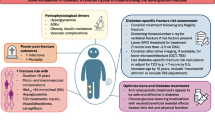Abstract
The mechanism of action of retardation of postmenopausal bone loss may be different for dietary calcium augmentation and hormonal replacement therapy (HRT). We performed a three-arm, placebo-controlled, randomized clinical trial comparing an intake of calcium of 1700 mg with: (1) calcium augmentation with HRT and (2) placebo. One hundred and eighteen women entered the study; 17 patients dropped out of the study. The vast majority of women were less than 2 years postmenopause. Bone mineral density declined significantly in the placebo group. The previously reported rates of change in the HRT group were significantly positive for total body calcium and the trochanter and not significantly different from zero for the others. The rate of change in the calcium augmentation group was intermediate between that in the two other groups, and achieved statistical significance compared with placebo for the total body calcium measurement and for the neck of the femur. Measurements were made prior to treatment and at the end of the study (2.9 years ±1.1 SD) for parameters of bone turnover and the calcitrophic hormones, to examine whether the mechanism of action was different for calcium augmentation versus hormonal therapy. There were no changes in the placebo group. The calcium augmentation group had a significant increase in 24-h urinary calcium and declining values for urinary collagen cross-links (pyridi-nium and deoxypyridinium), urinary hydroxyproline and calcitriol. The group treated with HRT and dietary calcium augmentation also had an increase in urinary calcium and a decline in collagen cross-links and urinary hydroxyproline and skeletal alkaline phosphatase; serum calcitriol did not change. The HRT group also displayed a drop in serum osteocalcin, and an increase in nephrogenous cAMP. Serum parathyroid hormone remained unchanged in all groups. Dietary calcium augmentation retards postmenopausal bone loss by decreasing resorption. The addition of HRT results in a more marked decline in bone resorption parameters and a suppression of parameters of bone formation. Whereas calcium augmentation suppressed calcitriol levels, the addition of HRT resulted in maintenance of calcitriol levels, possibly through enhancement of the renal effects of parathyroid hormone, although other mechanisms are possible.
Similar content being viewed by others
References
Aloia, JF, Vaswani A, Yeh JK, et al. Calcium supplementation with and without hormone replacement therapy to prevent postmenopausal bone loss. Ann Intern Med 1994;120:97–103.
Hollis BW. Assay of circulating 1,25-dihydroxyvitamin D involving a novel single-cartridge extraction and purification procedures. Clinical Chem 1986;32:2960.
Christiansen C, Riis BJ. 17β-Estradiol and continuous norethis-terone: a unique treatment for established osteoporosis in elderly women. J Clin Endocrinol Metab 1990;17:836–41.
Johansen JF, Delmas PD, Riis BJ, etal. Serum-free gamma-carboxyglutamic acid (free Gla) is a poor biochemical marker of bone resorption in early menopausal women. Bone 1991;12:257–60.
Ettinger B. Genant HK, Steiger P, et al. Low-dose micronized 17 β-estradiol prevents bone loss in postmenopausal women. Am J Obstet Gynecol 1992;166:479–88.
Aloia JF, Vaswani AN, Yeh JK, et al. Determinants of bone mass in postmenopausal women. Arch Intern Med 1983;143:1700–4.
Prince RL, Smith D, Dick IM, et al. Prevention of postmenopausal osteoporosis: a comparative study of exercise, calcium supplementation, and hormone-replacement therapy. N Engl J Med 1991;325:1189–95.
Hartwell D, Hassager C, Overgaard K, et al. Vitamin D metabolism in osteoporotic women during treatment with estrogen, an anabolic steroid, or calcitonin. Acta Endocrinol (Copenh) 1990;122:715–21.
Gallagher JC, Riggs BL, DeLuca HF. Effect of estrogen on calcium absorption and serum vitamin D metabolites in postmenopausal osteoporosis. J clin Endocrinol Metab 1980;51:1359–64.
Gennari C, Agnusdel D, Nardi P, et al. Estrogen preserves a normal intestinal responsiveness to 1,25-dihydroxyvitamin D3 in oophorectomized women. J Clin Endocrinol Metab 1990;71:1288–93.
Marcus R, Villa ML, Cheema M, et al. Effects of conjugated estrogen on the calcitriol response to parathyroid hormone in postmenopausal women. J Clin Endocrinol Metab 1992;74:413–8.
Civitelli R, Agnusdei D, Nardi P, et al. Effects of one-year treatment with estrogens on bone mass, intestinal calcium absorption, and 25-hydroxyvitamin D-1-hydroxylase reserve in postmenopausal osteoporosis. Calcif Tissue Int 1988;42:77–86.
Adami S, Gatti D, Bertoldo F, et al. The effects of menopause and estrogen replacement therapy on the renal handling of calcium. Osteoporosis Int 1992;2:180–5.
Falch JA, Gautvik KM. A longitudinal study of pre- and post-menopausal changes in calcium metabolism. Bone 1988;9:15–9.
Prince RL, Dick I, Garcia-Webb P, et al. The effects of the menopause on calcitriol and parathyroid hormone: response to a low dietary calcium stress test. J Clin Endocrinol Metab 1990;70:1119–23.
Marcus R, Madvig P, Young G. Age-related changes in parathyroid hormone and parathyroid hormone action in normal humans. J Clin Endocrinol Metab 1984;58:223–30.
Gallagher JC, Riggs BL, Jerpbak CM, et al. The effect of age on serum immunoreactive parathyroid hormone in normal and osteoporotic women. J Lab Clin Med 1980;95:373–85.
Lau EMC, Woo J, Leung PC, et al. The effects of calcium supplementation and exercise on bone density in elderly Chinese women. Osteoporosis Int 1992;2:168–73.
Kushuhara R, Katayama S, Itabashi A, et al. Effect of dietary calcium on serum BGP (osteocalcin). Endocrinol Jpn 1991;38:145–9.
Nordin BEC, Need AG, Morris HA, et al. Evidence for a renal calcium leak in postmenopausal women. J Clin Endocrinol Metab 1991;72:401–7.
Nordin BEC, Morris HA, Need AG, et al. Relationship between plasma calcium fractions, other bone-related variables, and serum follicle-stimulating hormone levels in premenopausal, perimenopausal, and postmenopausal women. Am J Obstet Gynecol 1990;163:140–5.
Joborn C, Ljunghall S, Larsson K, et al. Skeletal responsiveness to parathyroid hormone in healthy females: relationship to menopause and oestrogen replacement. Clin Endocrinol 1991;34:335–9.
Cosman F, Shen V, Xie F, et al. Estrogen protection against bone resorbing effects of parathyroid hormone infusion. Ann Intern Med 1993;118:337–43.
Heaney RP. A unified concept of osteoporosis. Am J Med 1965;39:377–80.
Author information
Authors and Affiliations
Rights and permissions
About this article
Cite this article
Aloia, J.F., Vaswani, A., Yeh, J.K. et al. Differential effects of dietary calcium augmentation and hormone replacement therapy on bone turnover and serum levels of calcitrophic hormones. Osteoporosis Int 6, 55–62 (1996). https://doi.org/10.1007/BF01626539
Received:
Accepted:
Issue Date:
DOI: https://doi.org/10.1007/BF01626539




